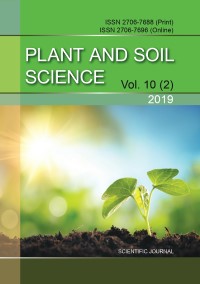Characteristic of morphological features of vegetative parts of trees endangered apple varieties of the Transcarpathian region
DOI:
https://doi.org/10.31548/agr2019.02.081Keywords:
apple tree, resistant varieties, organic growing, preservation of the gene pool, morphological features of the treesAbstract
In Transcarpathian region there are all conditions for development of organic gardening. For its implementation, local varieties that have developed resistance to major diseases over the centuries and adapted to local soil and climatic conditions can be used. Aboriginal varieties disappear and are replaced by new, popular varieties. Therefore, it is necessary to preserve the gene pool of these varieties for use in breeding and possibly in organic production technologies.
When cultivating varieties in tree nurseries it is necessary to study the varietal anatomical and morphological characteristics of seedlings well, which makes it possible to distinguish them among themselves in the absence of fruits. That was the purpose of our research.
The best varieties with high productive indices without the use of pesticides were allocated (Polovanya, Krasa Zakarpattia, Solivarske, Batul, Durnayka, Shtetin red, Ferkovanya). All these varieties are resistant to major diseases, including scab, and partially to powdery mildew and cancer. Morphological characteristics of trees described in accordance with the methodology of description of varieties. During the years 2015-2018, summer grafting (budding) and spring grafting were carried out on M9, MM-106, apple seedlings rootstocks. An estimation of the growth power of seedlings on these rootstocks was made.
We have come to the conclusion that most of them: Durnayka, Solivarske, Polovanya, Ferkovanya have a strong power of growth; Krasa Zakarpattia and the Stetin red have moderate power of growth and Batul has a weak one.
These varieties have the perspective of using in intensive organic orchards while a condition of growing them on the corresponding rootstocks. All varieties have good compatibility with M9 and MM-106 rootstocks, which are most commonly used in industrial orchards in Ukraine.References
Kondratenko, T. Ye., Kuzminets, O. M. (2008). Morfolohichni oznaky sadzhantsiv i zhyvtsiv yabluni raionovanykh ta perspektyvnykh sortiv [Morphological signs of seedlings and cuttings of apple trees of regional and perspective varieties]. Kyiv, Ukraine: VAT Polihrafknyha, 120.
Kondratenko, T. Ye. (2010). Sorty yabluni dlia promyslovykh i amatorskykh sadiv Ukrainy [Apple varieties for industrial and amateur orchards of Ukraine]. Kyiv: Manuskrypt-ASV, 400.
Lytovchenko, O. M., Pavliuk, V. V., Omelchenko, I. K. (2011). Krashchi sorty plodovykh i horikhoplidnykh kultur ukrainskoi selektsii [The best varieties of fruit and nut cultures of Ukrainian selection]. Kyiv: Pressa Ukrayny, 144.
Tkachyk, S. O. ed. (2016). Metodyka provedennia ekspertyzy sortiv roslyn hrupy plodovykh, yahidnykh, horikhoplidnykh ta vynohradu na vidminnist, odnoridnist i stabilnist [Methodology of examination of varieties of plants of the group of fruits, berries, nuts, and grapes on difference, homogeneity and stability]. Vinnytsia: FOP Korzun D.Yu., 850.
Omelchenko, I. K., Hrynyk V. I. (2012). Sadivnycha nauka Ukrainy: mynule, sohodennia, perspektyvy [Horticulture of Ukraine: past, present, possibilities]. Kyiv: Presa Ukrainy, Instytut sadivnytstva NAAN Ukrainy, 528.
Sharapatka, B., Urban, Y. et al. (2010). Orhanycheskoe selskoe khoziaistvo [Organic agriculture]. Olomouts.: Byoynstytut., 402.
Kondratenko, P. V., Kondratenko, T. Ye. ed. (2013). Pomolohiia. Yablunia [Pomology. Apple]. Vinnytsia: TOV Nilan-LTD, 626.
Savina, O. I. (2013). Selektsiia plodovykh i yahidnykh kultur [Selection of fruit and berry crops]. Uzhhorod: Hoverla, 140.
Downloads
Published
Issue
Section
License
Relationship between right holders and users shall be governed by the terms of the license Creative Commons Attribution – non-commercial – Distribution On Same Conditions 4.0 international (CC BY-NC-SA 4.0):https://creativecommons.org/licenses/by-nc-sa/4.0/deed.uk
Authors who publish with this journal agree to the following terms:
- Authors retain copyright and grant the journal right of first publication with the work simultaneously licensed under a Creative Commons Attribution License that allows others to share the work with an acknowledgement of the work's authorship and initial publication in this journal.
- Authors are able to enter into separate, additional contractual arrangements for the non-exclusive distribution of the journal's published version of the work (e.g., post it to an institutional repository or publish it in a book), with an acknowledgement of its initial publication in this journal.
- Authors are permitted and encouraged to post their work online (e.g., in institutional repositories or on their website) prior to and during the submission process, as it can lead to productive exchanges, as well as earlier and greater citation of published work (See The Effect of Open Access).

